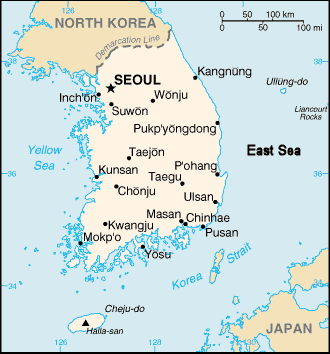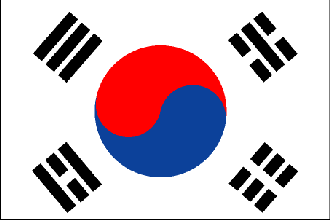
|
South Korea
Background:
After World War II, a republic was set up in the southern half of
the Korean Peninsula while a communist-style government was installed in the
north. After the Korean War (1950-53), South Korea achieved rapid economic
growth, with per capita
income rising to 13 times the level of North Korea. South Korea has also
maintained its commitment to democratize its
political processes.
Location:
Eastern Asia, southern half of the Korean Peninsula bordering the Sea
of Japan and the Yellow Sea.
Area: Land: 98,190 sq km, water: 290 sq km.
Area - comparative: Slightly larger than Indiana.
Land boundaries: North Korea 238 km.
Coastline: 2,413 km.
Climate and Terrain:
Climate: Temperate, with rainfall heavier in summer than winter.
Terrain: Mostly hills and mountains; wide coastal plains in west and south.
Elevation extremes: Lowest point: Sea of Japan 0 m, highest point: Halla-san
1,950 m.
Natural resources: coal, tungsten, graphite, molybdenum, lead, hydropower
potential
Land use: Arable land: 19%, permanent crops: 2%, permanent pastures: 1%,
forests and woodland: 65%, other: 13%.
People:
Population: 47,904,370 (July 2001 est.)
Ethnic groups: Homogeneous (except for about 20,000 Chinese)
Religions: Christian 49%, Buddhist 47%, Confucianist 3%.
Languages: Korean, English widely taught in junior high and high school.
Government:
Government type: Republic.
Capital: Seoul.
Economy overview:
As one of the Four Dragons of East Asia, South Korea has
achieved an incredible record of growth. Three decades ago GDP per capita was
comparable with levels in the poorer countries of Africa and Asia. Today its
GDP per capita is 7 times India's, 16 times North Korea's, and comparable
to the lesser economies of the European Union. The government promoted the
import of raw materials and technology at the expense of consumer goods and
encouraged savings and investment over consumption.
Labor force - by occupation: Services 68%, industry 20%, agriculture 12% .
Unemployment rate: 4.1%.
Industries: Electronics, automobile production, chemicals, shipbuilding, steel,
textiles, clothing, footwear, food processing
Statistics:
Telephones 24 million.
Telephones - mobile cellular: 27 million.
Radio broadcast stations: AM 106, FM 97, short-wave 6.
Radios: 47.5 million.
Television broadcast stations: 121 (plus 850 repeater stations and the
eight-channel American Forces Korea Network .
Televisions: 15.9 million.
Internet country code: .kr
Internet Service Providers (ISPs): 11.
Internet users: 15.3 million.
Railways: Total: 6,240 km.
Highways: Total: 87,534 km, paved: 65,388 km (including 1,996 km of
expressways), unpaved: 22,146 km .
Airports - with paved runways: Total: 68,
unpaved runways: Total: 34.
Heliports: 203.
Military expenditures - percent of GDP: 3.2%.
Return to Visiting Locations
|

